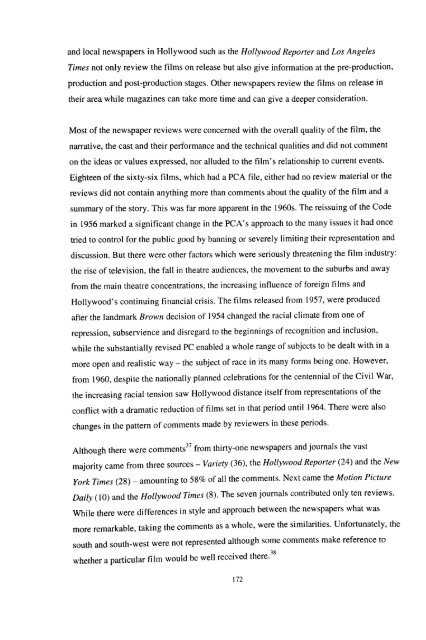Download (3483kB) - Greenwich Academic Literature Archive ...
Download (3483kB) - Greenwich Academic Literature Archive ...
Download (3483kB) - Greenwich Academic Literature Archive ...
- No tags were found...
You also want an ePaper? Increase the reach of your titles
YUMPU automatically turns print PDFs into web optimized ePapers that Google loves.
and local newspapers in Hollywood such as the Hollywood Reporter and Los AngelesTimes not only review the films on release but also give information at the pre-production,production and post-production stages. Other newspapers review the films on release intheir area while magazines can take more time and can give a deeper consideration.Most of the newspaper reviews were concerned with the overall quality of the film, thenarrative, the cast and their performance and the technical qualities and did not commenton the ideas or values expressed, nor alluded to the film's relationship to current events.Eighteen of the sixty-six films, which had a PCA file, either had no review material or thereviews did not contain anything more than comments about the quality of the film and asummary of the story. This was far more apparent in the 1960s. The reissuing of the Codein 1956 marked a significant change in the PCA's approach to the many issues it had oncetried to control for the public good by banning or severely limiting their representation anddiscussion. But there were other factors which were seriously threatening the film industry:the rise of television, the fall in theatre audiences, the movement to the suburbs and awayfrom the main theatre concentrations, the increasing influence of foreign films andHollywood's continuing financial crisis. The films released from 1957, were producedafter the landmark Brown decision of 1954 changed the racial climate from one ofrepression, subservience and disregard to the beginnings of recognition and inclusion,while the substantially revised PC enabled a whole range of subjects to be dealt with in amore open and realistic way - the subject of race in its many forms being one. However,from 1960, despite the nationally planned celebrations for the centennial of the Civil War,the increasing racial tension saw Hollywood distance itself from representations of theconflict with a dramatic reduction of films set in that period until 1964. There were alsochanges in the pattern of comments made by reviewers in these periods.Although there were comments 37 from thirty-one newspapers and journals the vastmajority came from three sources - Variety (36), the Hollywood Reporter (24) and the NewYork Times (28) - amounting to 58% of all the comments. Next came the Motion PictureDaily (10) and the Hollywood Times (8). The seven journals contributed only ten reviews.While there were differences in style and approach between the newspapers what wasmore remarkable, taking the comments as a whole, were the similarities. Unfortunately, thesouth and south-west were not represented although some comments make reference towhether a particular film would be well received there.172TO
















